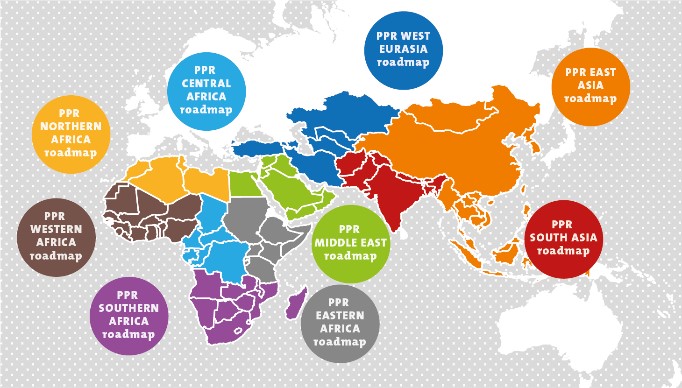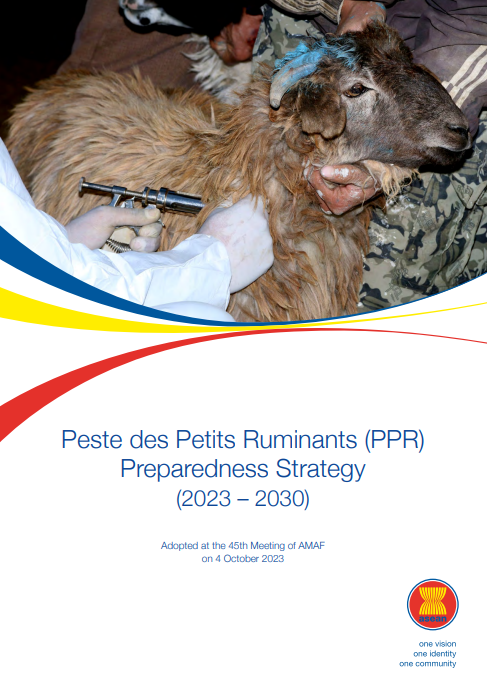Global Framework for the Progressive Control of Transboundary Animal Diseases
Peste des petits ruminants (PPR) is a viral disease, caused by a morbillivirus closely related to rinderpest virus, which affects goats, sheep, and some wild relatives of domesticated small ruminants. In the worst situations, PPR-related morbidity is as high as 100%, with a mortality rate that can reach 90%. In areas where the disease is endemic, the mortality rate may be lower, but the disease has a more insidious impact on flock productivity. Each year, PPR causes economic losses worth an estimated USD 1.2 to 1.7 billion, due to animal deaths, reduced production and the cost of fighting the disease. Approximately a quarter of the financial impact occurs in South Asia.
The World Organisation for Animal Health (WOAH, founded as OIE) and the FAO, in their joint Global Strategy for control and eradication of PPR, have set the goal of eradicating this disease by 2030. The Strategy includes several tools and components to be implemented through a step-wise approach to decreasing levels of epidemiological risk and increasing levels of prevention and control.
More information here (official WOAH statuses in respect of PPR).
To drive the PPR eradication effort on a global scale and effectively support countries in fighting the disease, FAO and WOAH established a Joint PPR Secretariat in March 2016, which will oversee the implementation of the adopted PPR Global Control and Eradication Strategy (PPR GSCE).
In October 2016, an initial PPR Global Eradication Programme (PPR GEP) for 2017-2021, was launched by FAO and WOAH to put the PPR GCES into action. The PPR GEP is a multi-country, multi-stage process that will decrease epidemiological risk levels and increase prevention and control.
The regional intergovernmental organisation, the Association of Southeast Asian Nations (ASEAN), is crucial in promoting economic growth and cooperation among its member states. Therefore, the ASEAN Sectoral Working Group on Livestock (ASWGL) decided to develop a regional PPR Preparedness Strategy in its 2021 meeting to support ASEAN Member States to
prevent PPRV incursions, rapidly detect and contain PPR outbreaks, and enhance coordination and information sharing in the ASEAN region.
The ASEAN PPR Preparedness Strategy was prepared in consultation with a core group of experts and WOAH.
The transborder nature of PPR requires actions to be harmonised in all countries in the same region. Therefore, regional coordination is essential for a successful implementation of the Global Strategy. In our region, East Asia (ASEAN, China, Mongolia & Timor Leste) and South Asia (SAARC) are recognized as the two of the nine regions in which the progress towards eradication of PPR will be assessed in regional roadmap meetings. Regional action plans outline the control and eradication measures to be implemented at national and regional levels.
The PPR Global Strategy recognizes that good quality Veterinary Services are indispensable for the successful and sustainable implementation of PPR (and other major Transboundary Animal Diseases) prevention and control activities.
Therefore, Veterinary Services’ capacity must be strengthened as a country moves forward. This in turn will create more cost-effective opportunities to control other priority diseases. This will be attained through appropriate combinations of activities such as vaccinations against PPR and other major diseases, epidemiological investigations, diagnostic activities and treatments.
The PVS Pathway will serve to evaluate Veterinary Services’ compliance with WOAH standards, to identify the cost of the gaps to be addressed for compliance and to address other issues such as veterinary laboratories, relevant legislation and education.
More information: PVS Activities in the Region
In Asia and the Pacific region, the WOAH Reference Laboratory for PPR is located in China Animal Health and Epidemiology Center (CAHEC), P.R. China, which can provide scientific and technical training for personnel from Member Countries and coordinate scientific and technical studies in collaboration with other laboratories or organisations, including through the Laboratory Twinning Programme. Since being recognized as an official organisational Reference Laboratory in 2014, it has organized training courses and technical workshops for members of the Asia-Pacific region every year, which has greatly strengthened disease diagnosis/surveillance capacity and implementation of control activities for our region.
PPR: an illustration of our contribution to address global challenges


